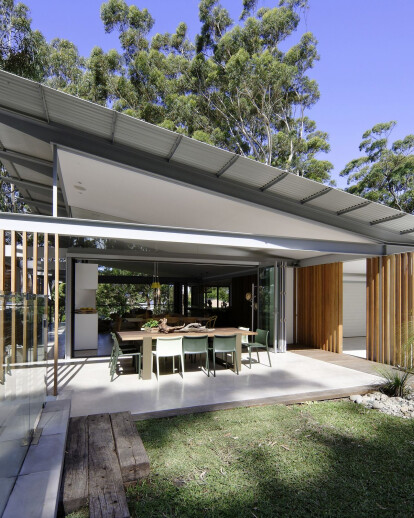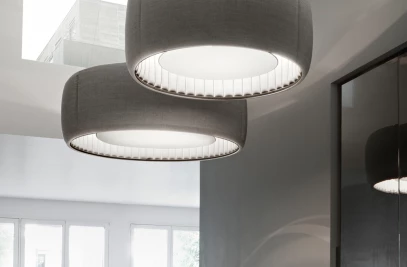A casual holiday home along the Australian coast by Architecture Saville Isaacs. A place where extended family and friends from afar can gather to create new memories. Robust enough for hordes of children, yet with an element of luxury for the adults.
Referencing the unique position between sea and the Australian bush, by means of textures, textiles, materials, colours and smells, to evoke a timeless connection to place, intrinsic to the memories of family holidays.
Flexibility extends to opportunities for multiple activities: covered outdoor rooms, open living/dining zone, enclosed rumpus. Internal spaces delineated by timber spine formed by the timber walkway and vertical post screen, continuing down the suspended stairs under the kitchen island and out.
The house takes advantage of its orientation and bush setting, with sunlight, privacy and diagonal views modulated by pivoting timber screens.
Internal elements are extensions of architecture. Joinery is used as space making elements (timber screen wall folds over as support for benchtop). Contrast of solid textures, white linear planes, rhythms of timber posts, smooth polished concrete, steel and glass against rough sawn wire-brushed timber create drama that animates the interiors.
Architecture Saville Isaacs key principal entails a focus on the tactile quality of materials: a consistent palette of polished concrete, waxed recycled wire-brushed tallowwood, textured white laminate joinery - selected for robustness, low maintenance and recyclability. Low VOC, non-toxic materials and finishes, hydronic floor heating and cross ventilation ensure a healthy indoor environment.
Architecture Saville Isaacs design was achieve through the integrated interior furnishing concept with a focus on palette of natural materials and finishes, locally sourced, designed and made. These choices being environmentally responsible and brief responsive by blending into and creating an emotive response to the Australian bush.
Architecture Saville Isaacs has focused on the interrelationship with surrounding environment, volumetric quality, light enhanced sculpted open spaces, and tactile quality of materials. The design by Architecture Saville Isaacs promotes the unity of architecture and interiors. It works with the elements of materiality, space, volume and light seeking to achieve a sense of peace and tranquillity.
What is Architecture Saville Isaacs conceptual framework of the project – including underlying principles, values, core ideas and/or philosophy.
The core idea of people living and engaging with place is an underlying principle of Architecture Saville Isaacs practice. Given expression in the manner in which this home engages with it’s surroundings, not in a general expansive nod to view, but in a varied and intimate manner.
This project by Architecture Saville Isaacs seeks to demonstrate that it is possible to achieve beautiful design using ESD principles and sustainable, recycled, low-toxic, cost-effective materials. It shows that focusing on the interrelationship with the surrounding environment, the volumetric quality and light enhanced sculpted open spaces, as well as the tactile quality of the materials, there is no need to showcase expensive finishes, and create aesthetic gymnastics. The design avoids fashion to work with timeless elements of materiality, space, volume and light seeking to achieve a sense of calm, peace and tranquillity.
As an ongoing approach of Architecture Saville Isaacs as an architectural practice is to seek to express each element and material honestly and emphasise its tactile qualities. Wire brushed timber has been used throughout with a waxed finish. The timber is offset against subtle palette of soft grey polished concrete floors and off white walls and joinery.
Junctions are finely detailed to clearly delineate and express the different materials and to render the structure and construction legible. The living room façades fold open, enabling a seamless integration of indoor and outdoor rooms. The roof appears to hover.
It is how these everyday, cost effective materials are put together and expressed, that creates the quality of space and architecture
What was the client brief given to Architecture Saville Isaacs to respond to
The client brief to Architecture Saville Isaacs was for a holiday house for a young family where extended family could gather to share holidays and create memories; flexible enough to accommodate 14 people; robust enough for hoards of children; and still have element of luxury for adults.
The aim was to create a peaceful and healthy environment for our clients; to carefully construct a place to live in which everyday living is a joy and every simple function gives pause to reflect, by connecting each function to the surrounding nature; and to achieve this using ESD principles and sustainable, recycled, low-toxic and cost-effective materials.
What is the relationship of the built form to the context of the project?
Placemaking in this context is tool with which to experience different aspects of site through varying times of day, seasons and weather patterns.
Architecture Saville Isaacs focused on each opening, carefully positioning them to capture/frame the outside – distant diagonal headland and ocean view or close bush.
Operable pivoting façade screen provides privacy from busy road and northern neighbour and sun control whilst still enabling view access.
Form of building sculpting covered and open outdoor spaces to accommodate varying use and relationship to outdoors with a solid base with a light/ floating top.
Architecture Saville Isaacs has created defined outdoor spaces at each level for different use opportunities - front garden, side play court & rear garden.
How did Architecture Saville Isaacs integrated with allied disciplines on the project and how have the contributions of others, including architects, interior designers, landscape architects, builders and other specialists, helped achieve the outcome?
The Architects of Architecture Saville Isaacs are also interior archtiects. The architecture and interior design of the project was closesly integrated. This integration of the interior design and the architecture as well as interior decoration are seamless. Architecture Saville Isaacs worked closely with local furniture makers and joiners. Architecture Saville Isaacs has used joinery as part of the architecture. The joinery elements are integral for space making - timber screen wall folds over to become support for island benchtop, kitchen joinery becomes wall and door, living room joinery is wall, storage, window and incorporates fireplace.
Architecture Saville Isaacs uses an architectural vocabulary to create a unique interior design language demonstrates the integral unity of architecture and interior design. Working in close collaboration with local builder allowed for outstanding quality of carpentry detailing.
How does the functional performance match the clients brief?
Brief for holiday house where extended family could gather to share holidays, create memories.
The house designed by Architecture Saville Isaacs allows for frequent use of the family with children whilst maintaining a luxury and sofistication for adults, accomodating an escape or weekend getaway.
The Result is a casual, robust home with strong relationship to outdoors and evocative views. Architecture Saville Isaacs designed the house so that it takes advantage of its orientation and bush setting with sunlight, views and privacy carefully balanced and modulated by pivoting and fixed timber screens.
How does this project demonstrate innovation and excellence in terms of environmental sustainability?
The houses utilises thermal mass, double glazing and shading result in very stable indoor temperatures, requiring minimal use of heating and cooling. Materials selections are robust and low maintenance and have been chosen for ability to be recycled. Low VOC and non-toxic materials and finishes, hydronic floor heating and cross ventilation ensure a healthy indoor environment.
Cost effective, common, locally produced materials used, with the raw beauty of the materials providing the sense of luxury, selected to ensure minimal impact on the greater environment, local environment (the site), as well as on the inhabitants health. Polished concrete used for the upper living level, with waxed recycled timber used internally for the lower bedroom level floors, stairs and screen walls and radially sawn plantation timbers externally. Floors, walls, roof and ceilings are heavily insulated. Materials carefully selected for longevity, low maintenance, resistance to wear and casual relaxed, lifestyle.
Non-toxic materials and finishes have been used: waxed timber, laminate joinery, no carpets, low VOC paints.
Passive climatic design strategies (orientation, winter solar penetration, screening/shading, thermal mass, cross ventilation utilising hilltop breezes) result in very stable indoor temperatures, requiring minimal use of heating and cooling.
The design responds to the challenges of the east – west orientation, with deep covered verandahs on both sides, furnished as outdoor rooms, and the roof tipped up to the north to capture winter sun.
Active strategies: solar hydronic heating, gas fireplace, cross ventilation and stack effect, ceiling fans, airconditioning (rumpus and master bedrooms only).
Rainwater collection used for toilets, laundry, native landscaping.
Cost/value outcome – How effective were the decisions related to financial issues?
The budget was modest; focussing on longevity, robustness and simple finishes, with investment in the quality of the carpentry detailing in close collaboration with the local builder.
Cost effective, common, locally produced materials have been used in innovative ways with the raw beauty of the materials providing the sense of luxury. Materials have been chosen for their robustness, ability to withstand wear and tear as well as considerations to minimise embodied energy and cost. These same considerations were employed in the selection and specification of the locally designed and manufactured custom furniture.
In 150 words or less, can you tell us about Architecture Saville Isaacs Studio and how it relates to the project
Architecture Saville Isaacs is a dynamic, focused architectural practice, providing a unique combination of award winning design skills and a strong commercial sensibility.
Architecture Saville Isaacs we have a passion for architecture, the practice of architecture and the construction of buildings. We are inspired by architecture’s ability to contribute to the public realm.
Architecture Saville Isaacs is experienced at exploring potentially complicated and difficult projects in a manner that provides developers the best possible result for their particular project, focusing on helping developers achieve their commercial outcomes by understanding the client’s perspective and thinking outside the box.
We have a pragmatic approach to construction and cost and use these constraints to inform design rather than be hindered by it. We are often called in to review existing designs in order to achieve greater efficiency and improved yield. We find it a rewarding challenge to explore the potentials of new development





























